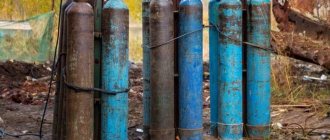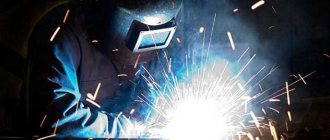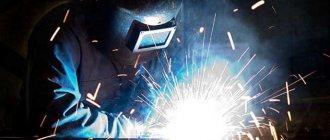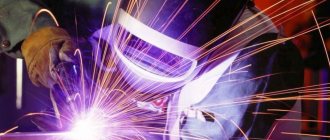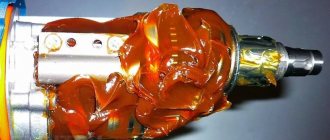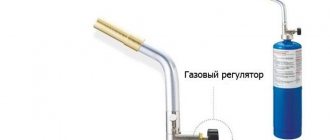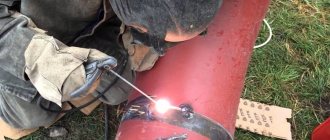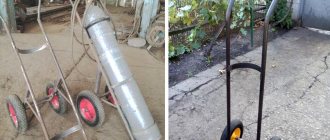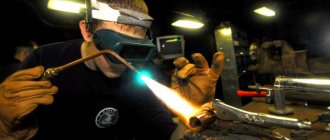Why do you need a reducer for a gas cylinder? The easiest way to answer the question is by comparing a household reducer for a gas cylinder with a mains voltage regulator. For a thrifty owner, the use of an electrical stabilizer has long become the norm. A gas reducer for a cylinder is used for exactly the same purpose - to stabilize the pressure coming from the gas cylinder to our household appliances.
Reducing gas pressure to operating parameters that ensure stable operation of the equipment - this is the main task performed by a cylinder pressure reducing device. The characteristics of the inlet pressure are important for household appliances where the energy source is blue fuel.
It would seem that after we have found out why a cylinder reducer for propane and butane is needed, we can finish the article, say goodbye to the readers, and submit the work for publication. However, not everything is so simple, and it turns out that the gas reducer operates according to completely two different operating principles and is divided into two types of devices.
Heating a country house with bottled gas
To create a high-quality heating system for a private home, gas boilers are usually used. Compared to alternative heating appliances, they are the most cost-effective and easy to use. But what about those who do not have the opportunity to connect a private home to a centralized gas pipeline? From this article you will learn whether it is possible to heat a house with gas from cylinders and how to properly set up safe heating with gas cylinders.
- What is more profitable - to use a convector or a cylinder?
- Proper storage is the key to safety
- Advantages of gas cylinder heating
- Disadvantages of heating with liquefied gas
How to choose a propane reducer model?
Mandatory conditions for the industrial production devices under consideration must be:
- The presence of a metal cover that fits tightly to the body.
- Indelible marking indicating the pressure parameters for which the device is designed.
- Universal connection nipple for commonly used hose diameters (6.3 mm, 9 mm).
- Tight fit of all sealing parts (gaskets) to the corresponding surfaces. Usually, to check this, use a soap solution, when applied to the surface, no air bubbles should form
- Brass body (steel is prone to rust).
- Convenient handwheel for moving the adjusting screw.
- Spare gasket (optionally, an adapter for propane cylinders of European standard, Swedish or Norwegian production can also be included).
- Compliance with domestic safety standards - GOST 12.2.052 - 81.
In the process of choosing the standard size of a propane reducer, the permissible level of external temperatures at which its use does not pose a danger to others is also taken into account. Typically, the climatic class of these devices is UHL2, which allows the use of the gearbox in the temperature range of -25...+50°C. For the UHL class (temperate zone), the corresponding range is -15...+45°C. The coefficient of unevenness of the transmitted pressure should not exceed ±0.15.
The external condition of the device is also important for the possibility of using the gearbox. The body of the propane gearbox should not have surface dents or scratches, not to mention changes in shape. The same applies to the condition of the control pressure gauge. Before installing it in a stationary state, the pressure gauge should be checked for serviceability by supplying compressed air: if the instrument pointer is motionless, the gearbox cannot be used.
The purchased device must be fully consistent with the technical characteristics of the unit for which it is intended. In particular, gas consumption cannot exceed the operating characteristics of the gearbox. If the pressure at the outlet of the gearbox exceeds (compared to the nominal values), the automatic control of the main equipment, as a rule, fails, and the equipment itself is switched off. The limit values of the pressure used should not exceed the permissible values for equipment of this class by more than 10%. The device must have a certificate of conformity in Russia.
What is needed for installation and connection
You will need:
- gas stove for a summer house under a cylinder (configured for the use of liquefied gas);
- gas cylinder;
- gearbox;
- hose for connecting a gas stove or copper pipes of suitable diameter.
- 2 clamps for attaching the hose (on one side - to the adapter for connecting the stove, on the other - to the reducer);
- gas tap (not required, but recommended).
It’s already clear how to choose a gas stove; now we’ll figure out the rest of the components. Nothing complicated, but there are some peculiarities.
Cylinder material and size
First, let's talk about the material from which the liquefied gas cylinder is made. Until recently, there weren’t even such conversations. The gas cylinder was exclusively made of metal, and made of metal of decent thickness. Now there are also composite gas cylinders (also called Eurocylinders) and they are approved for use by gas services. If possible, it is better to buy just these. Why are they better? Here is a list of their advantages:
- 2 times lighter.
- They have a fusible insert that prevents explosion in case of overheating/fire.
- Allowed for transportation in regular cars.
- Do not accumulate static voltage.
- There are polymer cylinders with transparent inserts. They allow you to control both the degree of filling and the availability of gas.
The polymer cylinder has few disadvantages. The first is that it costs two to three times more than a metal one, but it is much easier to carry/transport. The second is that, with equal volume and dimensions, it is larger than its metal counterpart.
Now about the size of gas cylinders. The larger the volume of the gas cylinder, the longer the period between refills. But, on the other hand, larger volume cylinders have larger dimensions and weight, and are more difficult to carry/transport. In addition, it is easier to find a place for installation under a small cylinder.
In general, the choice is yours. Moreover, with the advent of composites, they appeared in different sizes - high and narrow, low and wide.
Gearbox
Why do you need a reducer on a gas cylinder? It performs several functions at once:
- Stabilizes the pressure at the outlet of the cylinder. The gas in the cylinder is under high pressure; for a stove it should be lower. This is what the gearbox does.
- When there is little gas left in the cylinder - 5-10% - the pressure reducer increases.
So the reducer on the gas cylinder helps improve safety and stabilizes the operation of the stove. It is better not to connect the stove without it. In this case, the more you open the tap on the stove, the more powerful the gas flow will come out. In addition to the fact that this is uneconomical, it can create a situation where the balloon starts to jump. In general, it is better not to operate it without a gearbox.
Please note that different types of reducers are used for metal and composite cylinders. Therefore, when purchasing, check the type of cylinder and its volume
And most importantly, to work with a liquefied gas cylinder you need a propane reducer.
Beware of gearboxes made in China....
If we talk about manufacturers, it is better to take Russian or European products. It's better to avoid the Chinese ones. Even those that have passed certification are made of very thin metal and quickly fail (begin to etch). In addition, many cannot withstand the size of the fittings. When connecting, this becomes a problem, since the hose is not put on tightly, and you have to somehow seal the connection.
Hose for gas stove
You can buy it in city gas stores or in construction stores/markets. But be sure to specify that you need it to connect a gas stove. It is correctly called a “gas hose”. The internal diameter should be 16 mm, the external diameter depends on the type of hose, and there should be an inscription on the surface (in yellow) stating that the hose is gas.
There are such gas hoses:
To connect the cylinder to a gas stove, you need a hose about a meter long - to fulfill the condition about the distance between the cylinder and the stove of 0.5 meters and leave some room for freedom of movement.
On one side, a union nut with a gasket should be installed on the hose. We connect this end to the outlet from the gas stove. If you just buy a piece of hose, you can install the corresponding gas adapter yourself by tightening the fastening with a metal clamp (don’t forget about the thick silicone gasket for sealing). On the other hand, the hose is connected to the reducer - it is pulled onto the fitting, then tightened with a clamp (do not forget to put the clamp on the hose and then connect it to the fitting).
How to choose a household propane reducer
The choice of a device for supplying a propane-butane mixture to gas-using equipment is based on two key parameters:
Sample passport for a gas stove
The operating mode of most household propane appliances is 30 mbar, 37 mbar or 50 mbar. Based on this indicator, the appropriate gearbox is selected. If its output pressure differs from the operating parameter of a gas stove, boiler or, for example, a grill, this may lead to improper operation of the equipment and even create an explosive situation.
The characteristics of the propane reducer can be seen on it - 3 kg/h and 29mbar
30 mbar, 1.5 kg/h (kg/h)
For stable and safe operation of the gas consumer, it is also important that its consumption does not exceed the performance of the gas reducer. In this case, the upper level of gearbox consumption is not standardized. That is, for a boiler with a power of 24 kW with a mass flow of 2 - 2.5 kg/h, it is permissible to install a gearbox with a capacity of 3 kg/h and higher - the automatic boiler or stove will still not allow “extra” gas to pass through.
0.45 m3 (for propane - butane)
1000 Pa - 1 kPa - 10 mbar
30 mbar - 0.03 bar
Some owners of autonomous gas supply systems make the mistake of purchasing industrial gearboxes instead of household ones, considering them more reliable. Firstly, such devices are an order of magnitude more expensive, and secondly, they are designed to work with more powerful gas equipment, so they are not always compatible with household appliances.
You should also pay attention to the type of thread of the device. Gearboxes designed to work with non-flammable gases are equipped with a right-hand thread, and with flammable gases they have a left-hand thread and a mark on the nut.
Rules for installation and operation of a gas reducer
To connect a propane reducer to gas-using equipment, two methods are used: using a herringbone fitting or using a threaded connection. The first option is considered the simplest and is often used to connect the cylinder to a gas stove. The second method is more reliable and aesthetic, in addition, it allows you to connect one propane tank to several consumers at once.
Connection via fitting
Whatever option is chosen, during the process of connecting the gas reducer and starting the system, you must adhere to the following instructions:
- Make sure there are no cracks or depressions on the housing, check the integrity of the pressure gauge (if equipped).
- Connect the device to the cylinder (gas holder). For better tightness of the threaded connection, you should additionally use flax or FUM tape.
- Connect the gas line to the outlet pipe of the reducer. When using a herringbone fitting, secure the pipe at the mounting location with a clamp.
- Slowly open the cylinder valve, then turn the tap on the gas consumer.
Required pressure and volume
The key characteristics of a gas reducer are inlet pressure, operating pressure and flow rate, or the maximum volume of gas passing through the device in an hour.
The inlet pressure is determined by the standard pressure in the cylinders and is usually 20 MPa.
Technical characteristics of gearboxes
The operating pressure for household unregulated gas reducers is set at 0.3 MPa ±5%
For adjustable semi-professional and professional adapters, the operating pressure is set by the user in the range of 0-0.4 MPa, and for certain high-performance models - up to 1.6 MPa
The consumption volume must exceed the volume consumed by the device (or group of devices) per hour.
Checking pressure gauges on gas cylinders
When they talk about checking gearboxes, they actually mean checking pressure gauges on household gas cylinders. Let's reveal a secret: gearboxes are not listed in the state register of measuring instruments of the Russian Federation, but pressure gauges are present. And when specialists arrive, they check the operation of the flow meters - just like they check gas meters.
But it is also necessary to monitor the functioning of the gearbox, since these two devices work in conjunction. A malfunction of one of the elements will immediately affect the operation of the entire system.
Design and purpose of the flow meter
Pressure gauges that meet the requirements of GOST 2405-88 are installed on household gearboxes . The main purpose of the devices is to control the pressure in the gas system. To accurately set operating parameters, two devices are used - at the input and at the output.
The design of flow meters consists of the following elements:
- durable metal case, covered with glass on one side;
- scale with units of measurement – Pa, MPa, kgf/cm²;
- arrow painted in bright color;
- a sensitive element located inside the housing and driving the pointer.
The element responsible for rotating the arrow may differ. For low-pressure environments, membrane devices are used, but for gas networks spring models are more often used - the arrow moves due to the contraction or straightening of the spring.
To make it easier for the user to navigate and adjust the parameters as needed, a red line is placed on the scale - just opposite the working pressure marks.
Some installation and operation rules:
By color marking, household pressure gauges for gas reducers differ from similar equipment for other types of gas. If oxygen fittings are painted blue, ammonia fittings – yellow, acetylene fittings – white, then devices for propane-butane cylinders – only red.
Step-by-step instructions for connecting a gas cylinder at the dacha
Some stove models cannot be powered by bottled gas. High pressure is the main reason, and in the burners we can notice a yellow burning with the formation of soot.
By replacing methane nozzles with LPG nozzles, this situation can be changed. They are the same in shape, only the diameter is different. When connecting a new stove, there must be a set of jets to reduce gas. If a set is not available, jets can be purchased at reasonable prices.
The opening of the jets depends on the power of the burner and the gearbox itself. For using gas stoves, there are standard values for the diameter of the nozzle holes. Some manufacturers set their own diameter dimensions; nozzles that differ from these dimensions may void the warranty.
After assembling the installation, open the gas supply valve and use the reducer to set the required gas supply, that is, pressure. When gas passes through the system, all connections must be generously lubricated with soapy water and checked for gas leaks. If everything is fine, you can start lighting the fire. When the fire begins to smoke or has a yellowish color, it is necessary to reduce the gas supply, this is done using a reducer. When setting the minimum fire, all burners should be lit, but if one of them goes out, you need to adjust the low gas consumption knob on the stove tap. This can be done by increasing the pressure on the reducer.
How to convert a gas stove to bottled gas
In general, setting up a gas stove for bottled gas is not difficult; to properly adapt the stove you just need to change the gas supply nozzles to the burners. This can be easily done with your own hands without hiring specialists.
Gas is supplied to the burner using a special hole in the nozzle, which is an integral part of any gas stove. The hole can be of different diameters, depending on the pressure in the gas supply system. Of course, the pressure in the central gas lines is noticeably higher than in a conventional gas cylinder, and accordingly the diameter of the hole in the nozzle should be smaller.
Often, complete with a gas stove, the manufacturer also includes a set of jets designed for different types of gas mixtures - natural gas, propane-butane, etc. But if they weren’t there or the stove was bought a long time ago, it’s okay, you can buy the necessary jets in the store.
Choosing a jet for bottled gas
Jets (other names: nozzles, injectors, nozzles, etc.) for gas stoves are not in short supply; they can be bought at specialized retail outlets - markets, shops. In appearance, the nozzle is similar to a regular bolt with a thread applied, but unlike the latter, it has a hole in the center through which the gas actually passes. As we said earlier, the hole can be of different diameters, and usually its value is stamped on the end of the product.
Before buying a jet, you should determine what diameter is needed. This is an important point, since incorrectly selected jets will not allow the stove to work normally, or even make it impossible.
It is not difficult to understand that the stove is working correctly after replacing the jets:
the flame should burn without hissing, without yellow impurities and red tongues;
When lighting the burner, no popping noises are allowed, and the flame should not suddenly go out.
The required diameter of the nozzle hole is indicated in the instructions for the gas stove; if the instructions are lost, then information about your stove and its manual can be easily found on the Internet.
We categorically do not recommend changing the diameter of the nozzle hole yourself by caulking or drilling - new nozzles are not expensive, and “reworking” at home can have a detrimental effect on the operation of the stove.
What tools are needed?
To configure a gas stove for bottled gas and then connect it to a gas container, you will need the following tools:
first of all, new jets;
7 mm wrenches, wrenches or open-end wrenches;
a new flexible hose, 1.5 meters or more in length. Serves to connect the stove to a gas cylinder;
seal and gas reducer with outlet pressure 30 mBar.
Adjustable reducer for gas cylinder
Adjustable gas reducers operate on the same physical principles as non-adjustable ones and have a similar design. The difference is that the compression force of the reducing spring supporting the membrane can be changed using an adjusting screw coaxial with the spring in the simplest models, or using a flywheel and a more complex mechanical transmission.
Adjustable reducer for gas cylinder
The principle of operation is that by changing the pre-compression force of the reduction spring, the user changes the threshold gas pressure in the working chamber required to operate and close the intake valve. A pressure gauge is also added to the parts, installed on the working pipe and allowing you to visually monitor the result of the adjustment.
Design features and maintenance
Problem-free operation of the system is impossible without regular maintenance and elimination of minor gearbox faults. To do this, you need to know the design of the device and the signs of typical problems.
Diagram of direct and reverse acting devices
According to the type of design, gearboxes are divided into direct and reverse acting devices. In the first case, the excess pressure of the incoming gas is directed to open the valve, in the second - the insufficient pressure in the working chamber of the device.
The design of single-chamber direct and reverse acting gearboxes is simple. The absence of complex components is the reason for a long service life without breakdowns if the product is made with high quality
The basic elements of both types of gearbox designs are the same:
- fitting through which gas is supplied;
- high pressure gauge showing the pressure value of the gas supplied to the device;
- a return spring that works to close the valve;
- high pressure chamber;
- a valve whose position regulates the volume of gas passed through;
- a safety valve that is triggered when unacceptable pressure is reached in the working chamber;
- low pressure pressure gauge, which determines the value of the working gas pressure;
- working chamber (low pressure);
- an adjusting screw that determines the position of the membrane;
- main spring;
- working chamber membrane;
- pin between the main spring and the bypass valve.
Reverse-acting gearboxes have become more widespread because they are more reliable.
There are models equipped with a pneumatic pressure sensor, where instead of the main spring, gas acts on the membrane, ensuring the balance of the system.
As a rule, the adjusting screw is tight. This is due to the prevention of spontaneous changes in position under the influence of forces directed at the membrane. When it rotates clockwise, the volume of the working chamber decreases and the pressure of the exiting gas increases.
In ordinary gearboxes, the unevenness of the output pressure depends on the value of the input pressure and, as a rule, reaches 15-20%. Two-stage (or two-chamber) models are used when it is necessary to maintain the exact pressure of the exhaust gases.
This oxygen reducer well illustrates the design of the two-stage type: at its core, these are two separate devices connected together
Such gearboxes have a more complex design and slightly larger dimensions. They cost more than their single-stage counterparts. Therefore, if there is no need, their use is inappropriate.
Periodic inspection and service work
For long-term and proper operation of the gearbox, it is necessary to periodically carry out simple procedures with it. Once a week you need to record the pressure gauge readings. As the elasticity of the springs decreases, a slow but constant decrease or increase in pressure is possible.
The following actions must be performed once a quarter:
- Check the tightness of the interface of the gaskets , safety valve and pressure gauges with the device body. This procedure can be performed by applying a soap solution to areas of possible gas leaks.
- Blow out the safety valve to prevent it from sticking. To do this, it is necessary to connect the gearbox to a source of compressed air and, with the outlet closed, increase the pressure until the protective mechanism is activated.
Repair and maintenance work that involves physical impact on the device body (including tightening threaded connections) cannot be carried out when the gearbox is under pressure.
This is dangerous due to the release and ignition of flammable gases. In addition, a sudden depressurization of the device may occur with possible physical harm to people in the room.
Gas service specialists are required to conduct an annual technical inspection of equipment, identify non-compliance with safety requirements and issue instructions with an algorithm for eliminating them
Typical faults and their repair
Gas leaks and pressure deviations outside the standard range can be eliminated independently. The first problem may be caused by the following reasons:
- depressurization of the housing;
- membrane damage.
The passage of gas through a loose connection of the housing elements can be eliminated by replacing the liner or using silicone sealant. The damaged membrane must be replaced with a similar element from the repair kit.
The reasons for deviation of the pressure value may be:
- Spring problem. It is necessary to disassemble the gearbox and determine the cause of the malfunction. If the spring is displaced, it must be corrected; if broken, it must be replaced. If there is a loss of elasticity, then it is enough to place a hard gasket under it.
- Leakage of compressed gas in devices with a pneumatic principle of pressure on the membrane. It is very difficult to fix the problem on your own. The gearbox needs to be replaced.
- Membrane problem. If a rupture occurs, it is necessary to replace the device assembly, and if there is a loss of tightness at the connection points with the washers, this malfunction must be eliminated by tightening the edges.
- Bypass valve problem. If the rubber gasket is worn out, it must be replaced. If the movement of the rocker arm is disrupted, the hinges must be replaced.
Considering the low cost of gearboxes, it is advisable to repair it only if a quick replacement is impossible. If, as a result of actions with the device, it was disassembled, then for safety reasons it is necessary to check its tightness during the first start-up.
Safety regulations
If you smell gas, you should immediately call 04 and open the windows
A gas stove of any type is considered a high-risk appliance, therefore, it is extremely important to take into account all safety rules, which include the following recommendations:
The walls of the room must be heat-resistant and withstand temperatures of 100 degrees; The kitchen set must also be heat-resistant and able to withstand temperatures up to 100 degrees; The kitchen set should be installed no closer than 45 cm from the work surface;; All sockets must be grounded; If you smell gas, do not turn on the lights. The gas must be shut off and the room ventilated immediately.
It is also important to call emergency services; Utensils for cooking on a gas stove should be chosen from aluminum, ceramics, cast iron or steel. You can also use Teflon cookware.
Rules for operating a gas stove
Malfunctions. Repair.
If you decide to carry out repairs or adjustments yourself, make sure you have the necessary qualifications. Poor repair of gas equipment can cause a fire, explosion or poisoning. After completing the work and assembly, make sure that the device is tight and operates correctly. The tightness is checked by applying a soap solution to all joints. No bubbling indicates there is no leak. But you shouldn’t delude yourself. The tightness will need to be checked several more times (after a day, three days, a week of operation), and then checked regularly, since a leak may occur some time after the start of operation.
Main malfunctions: the gas pressure at the outlet does not correspond to the nominal value (reason: the spring is broken or deformed), gas leakage (reasons: the membrane is damaged, the tightness of the connection between the membrane and the housing is broken, the float valve is leaking)
Here is a selection of materials:
Everything you need to know about heating and climate control Features of the selection and maintenance of boilers and burners. Comparison of fuels (gas, diesel, oil, coal, wood, electricity). Do-it-yourself ovens. Coolant, radiators, pipes, heated floors, circulation pumps. Chimney cleaning. Conditioning
If the float bypass valve leaks, then the leak may not occur in the reducer itself, but somewhere further, for example, in a gas stove, since in this case, in zero consumption mode (when the stove or some other consumer is turned off), at the outlet reducer and gas pipes, the pressure can reach the inlet pressure. Gas gradually leaks through the valve, and there is nowhere for it to go. If there is a gas cylinder at the inlet, the pressure can reach 15 bar, which is 500 times higher than the nominal one. Such pressure will definitely lead to leakage. At the same time, it is difficult to detect this malfunction, since when the stove is turned on, the pressure normalizes. There is no sign of overpressure (flame blowout). The fault can only be identified by measuring the outlet pressure in zero consumption mode. It can be no more than 20% more than nominal.
To repair, the gearbox must be disassembled. Only a dismountable gearbox with a spring can be repaired. Sealed gearboxes are not suitable for repair.
In the picture, the membrane is with the bottom side up.
An inspection will show if there are defects in the membrane or a broken spring. A torn membrane can be replaced. But it’s not worth it, it’s better to buy a new gearbox, since it’s quite difficult to hermetically connect the new membrane with the washers. A broken spring can be replaced. Most often, the spring does not break, but simply compresses a little over time. As a result, the outlet pressure becomes lower than nominal. This malfunction can be easily corrected by placing a gasket between the housing and the spring. Read about this below in the section on transferring to another pressure.
Membrane - top view.
If you have diagnosed problems with the bypass valve, then you need to inspect it. It is a tube with a thin hole. A piece of hard rubber mounted on a rocker arm is pressed against the end of the tube. The valve may not close for the following reasons: Firstly
, the mobility of the rocker arm is impaired.
Move it with your hands, make sure it moves freely. If there are problems, grind or replace the hinges. Secondly
, a piece of rubber was worn out and torn.
It can be removed with a sharp knife and replaced by gluing another one of the appropriate size in its place. Thirdly
, the end of the inlet tube may not be smooth, with damage and roughness. This prevents a tight seal. The end can be sanded with fine sandpaper.
Very often, a leak occurs due to a leak in the seal between the membrane and the lower part of the housing. Troubleshooting is easy. You need to lubricate the edge of the lower part of the case where the membrane fits with silicone sealant, let it dry a little (10 minutes), install the membrane, assemble the gearbox and let it dry a little more (2 hours).
During disassembly and subsequent reassembly, it is quite easy to break the tightness of the membrane. If you have disassembled the gearbox, then during reassembly in any case, even if there was no leakage, use silicone sealant. This will improve reliability.
What is needed for installation and connection
- gas stove for a summer house under a cylinder (configured for the use of liquefied gas);
- gas cylinder;
- gearbox;
Gas stove for a summer house under a cylinder: connection rules when placing the cylinder indoors and outside
It’s already clear how to choose a gas stove; now we’ll figure out the rest of the components. Nothing complicated, but there are some peculiarities.
Cylinder material and size
First, let's talk about the material from which the liquefied gas cylinder is made. Until recently, there weren’t even such conversations. The gas cylinder was exclusively made of metal, and made of metal of decent thickness. Now there are also composite gas cylinders (also called Eurocylinders) and they are approved for use by gas services. If possible, it is better to buy just these. Why are they better? Here is a list of their advantages:
- 2 times lighter.
- They have a fusible insert that prevents explosion in case of overheating/fire.
- Allowed for transportation in regular cars.
- Do not accumulate static voltage.
Cylinders for liquefied household gas can also be composite (polymer)
The polymer cylinder has few disadvantages. The first is that it costs two to three times more than a metal one, but it is much easier to carry/transport. The second is that, with equal volume and dimensions, it is larger than its metal counterpart.
Now about the size of gas cylinders. The larger the volume of the gas cylinder, the longer the period between refills. But, on the other hand, larger volume cylinders have larger dimensions and weight, and are more difficult to carry/transport. In addition, it is easier to find a place for installation under a small cylinder.
In general, the choice is yours. Moreover, with the advent of composites, they appeared in different sizes - high and narrow, low and wide.
Gearbox
Why do you need a reducer on a gas cylinder? It performs several functions at once:
Stabilizes the pressure at the outlet of the cylinder.
- The gas in the cylinder is under high pressure; for a stove it should be lower. This is what the gearbox does.
- When there is little gas left in the cylinder - 5-10% - the pressure reducer increases.
Types of reducers for propane gas cylinders
So the reducer on the gas cylinder helps improve safety and stabilizes the operation of the stove. It is better not to connect the stove without it. In this case, the more you open the tap on the stove, the more powerful the gas flow will come out. In addition to the fact that this is uneconomical, it can create a situation where the balloon starts to jump. In general, it is better not to operate it without a gearbox.
Please note that different types of reducers are used for metal and composite cylinders. Therefore, when purchasing, check the type of cylinder and its volume
And most importantly, to work with a liquefied gas cylinder you need a propane reducer.
Beware of gearboxes made in China....
If we talk about manufacturers, it is better to take Russian or European products. It's better to avoid the Chinese ones. Even those that have passed certification are made of very thin metal and quickly fail (begin to etch). In addition, many cannot withstand the size of the fittings. When connecting, this becomes a problem, since the hose is not put on tightly, and you have to somehow seal the connection.
Hose for gas stove
You can buy it in city gas stores or in construction stores/markets. But be sure to specify that you need it to connect a gas stove. It is correctly called a “gas hose”. The internal diameter should be 16 mm, the external diameter depends on the type of hose, and there should be an inscription on the surface (in yellow) stating that the hose is gas.
There are such gas hoses:
Hoses for connecting cylinders to a gas stove look like this
To connect the cylinder to a gas stove, you need a hose about a meter long - to fulfill the condition about the distance between the cylinder and the stove of 0.5 meters and leave some room for freedom of movement.
On one side, a union nut with a gasket should be installed on the hose. We connect this end to the outlet from the gas stove. If you just buy a piece of hose, you can install the corresponding gas adapter yourself by tightening the fastening with a metal clamp (don’t forget about the thick silicone gasket for sealing). On the other hand, the hose is connected to the reducer - it is pulled onto the fitting, then tightened with a clamp (do not forget to put the clamp on the hose and then connect it to the fitting).
How to choose a household propane reducer
The choice of a device for supplying a propane-butane mixture to gas-using equipment is based on two key parameters:
Sample passport for a gas stove
The operating mode of most household propane appliances is 30 mbar, 37 mbar or 50 mbar. Based on this indicator, the appropriate gearbox is selected. If its output pressure differs from the operating parameter of a gas stove, boiler or, for example, a grill, this may lead to improper operation of the equipment and even create an explosive situation.
The characteristics of the propane reducer can be seen on it - 3 kg/h and 29mbar
30 mbar, 1.5 kg/h (kg/h)
For stable and safe operation of the gas consumer, it is also important that its consumption does not exceed the performance of the gas reducer. In this case, the upper level of gearbox consumption is not standardized. That is, for a boiler with a power of 24 kW with a mass flow of 2 - 2.5 kg/h, it is permissible to install a gearbox with a capacity of 3 kg/h and higher - the automatic boiler or stove will still not allow “extra” gas to pass through.
0.45 m3 (for propane - butane)
1000 Pa - 1 kPa - 10 mbar
30 mbar - 0.03 bar
Some owners of autonomous gas supply systems make the mistake of purchasing industrial gearboxes instead of household ones, considering them more reliable. Firstly, such devices are an order of magnitude more expensive, and secondly, they are designed to work with more powerful gas equipment, so they are not always compatible with household appliances.
You should also pay attention to the type of thread of the device. Gearboxes designed to work with non-flammable gases are equipped with a right-hand thread, and with flammable gases they have a left-hand thread and a mark on the nut.
Rules for installation and operation of a gas reducer
To connect a propane reducer to gas-using equipment, two methods are used: using a herringbone fitting or using a threaded connection. The first option is considered the simplest and is often used to connect the cylinder to a gas stove. The second method is more reliable and aesthetic, in addition, it allows you to connect one propane tank to several consumers at once.
Connection via fitting
Whatever option is chosen, during the process of connecting the gas reducer and starting the system, you must adhere to the following instructions:
- Make sure there are no cracks or depressions on the housing, check the integrity of the pressure gauge (if equipped).
- Connect the device to the cylinder (gas holder). For better tightness of the threaded connection, you should additionally use flax or FUM tape.
- Connect the gas line to the outlet pipe of the reducer. When using a herringbone fitting, secure the pipe at the mounting location with a clamp.
- Slowly open the cylinder valve, then turn the tap on the gas consumer.
It is worth noting that the device is intended for use in temperate climates, so its use is permissible at temperatures from -15 to 45 degrees Celsius.
An example of connecting a propane reducer in a group cylinder installation
Connecting the hose to the gas stove
To connect the hose to the stove, look at the back of the stove. Here you can see the inscription “exit”. You will immediately need to determine what type it is. Perhaps it will be made absolutely straight or have a slight angle.
This is very important, so the hose is not allowed to bend too much. If the pipe is located a little to the side, and the outlet is made straight, you will have to purchase an additional metal elbow with a thread. When the thread diameter is 3/4 inch, you will also need to install an adapter (foot) with a diameter of half an inch
When the thread diameter is 3/4 inch, you will also need to install an adapter (foot) with a diameter of half an inch.
Usually in all kitchens the gas riser is installed in a certain corner. A welded tube equipped with a ball valve extends from it to connect a gas hose.
The union nut is screwed onto the tap. When the faucet has an internal thread, the hose must screw into it.
Before connecting a hose to the “output” of the system, you need to install a paronite gasket. It is usually sold as a set.
But it is better to purchase such a gasket on the market, equipped with a metal mesh. It will serve as protection against possible contamination.
Having installed the gasket, the flexible hose is screwed to the outlet of the stove and tightened with an open-end wrench.
Then a gas leak check is carried out. All connections must be thoroughly washed. Open the tap and let in the gas. The absence of bubbles at the connections indicates that the system is ready for use.
Connecting the plate to the cylinder
For this operation, you need to screw a fitting onto the gas stove pipe, and put a previously stored flexible gas hose on it and secure it with a worm-type clamp.
We attach the second end of the hose to the reducer and also tighten it with a clamp, and connect the reducer directly to the liquefied gas cylinder using paronite gaskets. Fastening is carried out using an open-end wrench; we place the gearbox in a horizontal position - this is important!
If everything is done correctly, there should be no gas leaks, but it is better to check this personally. To do this, use the simplest method - applying a soap solution to the joints. If there is a leak, it can be easily seen by the inflating soap bubbles. In this case, it is necessary to change the gaskets, tighten the clamps, and if there is damage to the hose, replace it.
Gas cylinder in the country - advantages and disadvantages
When a person just moves into a private house that is not connected to a gas pipeline, he finds himself at a crossroads - use an electric stove, or connect a gas stove, but use cylinders? Both solutions have a number of advantages and disadvantages.
The positive aspects of a gas cylinder are:
- A gas burner will heat everything several times faster. Cooking time will be significantly reduced, which means you will have more time for yourself or your family.
- The cost of refilling is much less than paying bills for used electricity. The only exception may be when you use electricity at preferential rates, for example, for people living in villages. There is also a discount on utility bills for those considered low-income.
- In certain regions, the rate of electricity consumption per person registered in the premises is limited to 50 kW per month, and if the limit is exceeded, the price increases.
Now about the disadvantages:
- Transportation costs, since there are gas stations, but they are much smaller than gasoline ones.
- It is impossible to know exactly how much fuel was filled into the cylinder.
- Installation of gas stoves in rooms where there is no ventilation is prohibited.
When we have figured out all the pros and cons, and you have decided to install cylinders, you can talk about where to place the fuel and stove.
Rules for operating gas equipment
Installation of gas equipment on cars requires periodic inspection and routine maintenance, the essence of which is as follows:
• constant checking of seals and connections, including those on the multivalve;
• replacement of gas and liquid phase filters every 10-12 thousand km (or if necessary). If filters with settling tanks are installed, drain the condensate (gasoline) as the container fills;
• replace repair kits for injectors and gearboxes in a timely manner - at least once every 40-50 thousand km. After a similar distance, bench cleaning of the jets is required, as well as cleaning the gearbox from carbon deposits;
• the service life of the cylinder is 10 years, pressure testing and pressure testing are required every two years. Touch up the cylinder if you notice signs of corrosion;
• spend time tuning the ECU. Gas equipment 4th generation
must be completely synchronized. If, due to incorrect settings, the ECU supplies more gas through the reducer than necessary, this is fraught with problems with the valves. In addition, tuning is an optimization of fuel consumption;
• change antifreeze and oil in a timely manner (according to the regulations, once every 2 years).
We strongly recommend checking gas equipment in Kharkov
or Kyiv only at specialized service stations that have a license from the manufacturer and where the installation took place directly.
For example, install gas equipment
at PRIDE GAS and check the gas equipment here. Finally, we will give some tips on how to extend the life of HBO:
• do not drive at high speeds too often. If you like to drive on the highways at the maximum capabilities of the engine, switch to gasoline;
• try to fill up only with high-quality gas at the same gas station;
• do not fill gas to more than 80% of the cylinder volume;
• listen to any changes in engine operation - they may be the first signal of problems with gas equipment.
Read also: How to ring a phone with a multimeter
Authorized PRIDE GAS centers (the official representative of AEB in Ukraine) are ready at any moment to provide you with high-quality practical and consulting assistance with gas equipment. From us you can buy 4th generation gas equipment for any number of cylinders, receiving a 3-year warranty. Our specialists will tell you in detail what routine maintenance needs to be done and when, and PRIDE by AEB kits will remind you of this (one of the built-in functions).
PRIDE by AEB – the best sets of gas equipment from Italy
for Ukrainian roads from PRIDE GAS!
Features of using composite gas cylinders
Composite gas cylinders have recently become increasingly popular. This is due to their advantages over their steel counterparts.
- Weight. Almost twice as light as steel.
- Ease of handling. There are comfortable handles.
- Transparency. The fill level can be easily seen.
- Convenient storage. Can be placed one on top of the other and stacked.
- Life time. The service life is practically unlimited.
- Operational safety. It is caused by the absence of sparking and a safety valve and fusible link built into the gas cylinder.
Composite cylinders supplied to the Russian market are produced in the Czech Republic, Norway and India. When purchasing such a cylinder, it is necessary to clarify the connection standard. If the gas cylinder is equipped according to the Russian standard, you can use a regular reducer for the gas cylinder. If the gas cylinder comes with a European connector, then you will need to either order an adapter or purchase an imported reducer. Please note that each additional connection increases the risk of gas leakage.
The need to use gas reducers
Without installing a special device - a reducer - the pressure in the autonomous gas network loses stability and changes depending on the filling of the cylinder and the composition of the fuel. To prevent this from happening, they install a device with a flow meter-pressure gauge, based on the readings of which one can judge the operating pressure.
Regulating equipment requires maintenance and from time to time undergoes verification, which is carried out by representatives of the service organization - the Gorgaz or Oblgaz service.
Homeowners are not allowed to check gas reducers, but can control the actions of workers, so we will analyze all the important points in order - from the design of the device to the frequency of calling gas workers.
Device, principle of operation and types
The design of the gearbox is simple, but its production is based on high precision manufacturing of all elements.
Devices from different manufacturers may differ, but the main parts of the design remain the same.
Propane device details:
- metal or polymer body;
- connecting pipe with union nut;
- working pipe with thread;
- filter unit;
- two chambers with a membrane between them;
- valve with seat on stem;
- two springs – supply and return;
- pressure gauge
There are two types of propane gearboxes: 1-stage and 2-stage. The difference lies in the method of reducing the pressure: in a single-stage process, the process occurs in one stage, in a two-stage process - in two. The structural difference of the second is the presence of a high-pressure chamber and an additional valve.
It is advisable to use a two-stage device for cylinders that have high inlet pressure, but in everyday life single-stage models are more often used.
To distinguish a propane device from oxygen or others, it is marked in red, but there are also “metallic” devices.
The operating principle is to regulate pressure. Entering the high-pressure chamber through the pipe, the gas presses on the membrane. The valve opens by means of a spring and allows fuel to flow into the next compartment - the low pressure chamber.
There, the gas acts on the membrane from the other side, as a result of which the pressure acquires operating parameters. Once this happens, the valve closes. The process is repeated as the parameters change.
The connection to the gas pipeline leading to the gas stove is made through the inlet pipe. For household cylinders, devices with a nipple outlet with a typical diameter of 6.3 mm are produced. They are cheaper than gearboxes for welding equipment.
Rules for safe operation
According to the instructions for the safe operation of reducers for gas cylinders, a number of rules must be followed. Before using the device, you need to make sure that it is in good working order and be sure to check the date of verification. If more than a year has passed since the last verification, the equipment cannot be used - you must contact the technical service and call a specialist.
The adapter must only be inserted with a working pressure gauge (or pressure gauges). To check, open the cylinder valve and follow the arrows on the instruments. The operating pressure is set based on the readings of the low pressure gauge. To adjust, turn the screw slowly.
When the valve is closed, operating parameters cannot be set. The high pressure gauge readings come in handy when you want to know the presence of propane in your tanks.
Sometimes troubles happen in which you should urgently call an emergency gas service, but some measures can be carried out independently. If the gearbox freezes, it is heated with steam or hot water, having previously closed and insulated the cylinder.
If you leave home for a long time, you need to turn off the gas - turn the shut-off valve installed inside the house, and be sure to tighten the cylinder valve.
The following actions cannot be performed:
- perform welding work near operating gas equipment;
- check the tightness with an open flame - a lighter or a match;
- warm frozen fittings with an open fire;
- install reducers for other purposes - for example, for oxygen or acetylene cylinders;
- use pressure gauges with inappropriate technical characteristics;
- use unverified and faulty pressure gauges.
If devices or connections have visible mechanical damage, we do not recommend using an autonomous network - you should call a specialist who will check the suitability of the equipment and issue a positive conclusion.
The rules for the safe operation of gas appliances can be found in PB 03-576-03.
